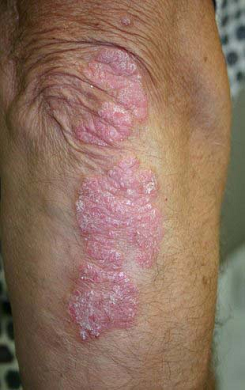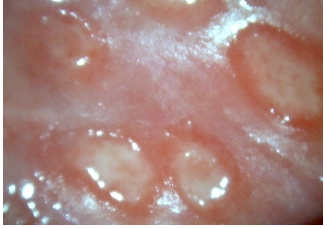Check out today’s Step 2 CK Qmax Question Challenge.
Know the answer? Post it in the comments below! Don’t forget to check back for an update with the correct answer and explanation (we’ll post it in the comments section below).
 A 21-year-old man presents to a dermatologist with the lesions shown in the image. The lesions have been present for approximately 3 months. They were much smaller when he first noticed them, and they have slowly gotten larger. He denies pruritus, joint pain, or fatigue. When a scale is removed, pinpoint bleeding is seen underneath.
A 21-year-old man presents to a dermatologist with the lesions shown in the image. The lesions have been present for approximately 3 months. They were much smaller when he first noticed them, and they have slowly gotten larger. He denies pruritus, joint pain, or fatigue. When a scale is removed, pinpoint bleeding is seen underneath.
What is the underlying pathology?
A. Antigen-mediated cross-linking of receptors on sensitized mast cells
B. Antinuclear antibodies and immune complex deposition
C. Cutaneous T-lymphocyte-mediated inflammation
D. Cutaneous yeast infection
E. Type II hypersensitivity reaction
———————–
Want to know the ‘bottom line?’ Purchase a USMLE-Rx Subscription and get many more features, more questions, and passages from First Aid, including images, references, and other facts relevant to this question.
This practice question is an actual question from the USMLE-Rx Step 2 CK test bank. Get more Step 2 CK study help atUSMLE-Rx.com.




cutaneous T-cell mediated inflammation. Psoriasis
Psoriasis
Psoriasis. Cutaneous T lymphocyte mediated inflammation
C
Psoriasis is a common autoimmune skin disease characterized by T cell-mediated hyperproliferation of keratinocytes
The correct answer is C. The lesion shown is psoriasis, which is thought to be a secondary inflammatory response to T-lymphocytes in the skin, resulting in a hyperproliferative state. Psoriatic lesions are erythematous papules and plaques characterized by silvery scales and punctuate bleeding when scales are removed (Auspitz sign). Psoriasis typically presents in young adults and the elderly with symmetric, largely asymptomatic (although they can be pruritic) plaque formation. Nail findings such as pitting are common, and arthritis are seen in a minority of patients.
A is not correct. This is a description of the type I hypersensitivity reaction, which is implicated in asthma and allergic reactions, but not in psoriasis.
B is not correct. Antinucelar antibodies and immune complex deposits are typically found in systemic lupus erythematosus, which can rarely be confused with psoriasis (joint pain and an erythematous rash). However, lupus does not typically manifest with the formation of the thick scales seen in psoriasis.
D is not correct. Yeast infection is often found in association with seborrheic dermatitis, though a causal relationship has not been established. Seborrheic dermatitis also manifests with an erythematous scaling rash; however, the scale tends to be finer and yellowish as opposed to the thick silvery scale seen in psoriasis.
E is not correct. The type II hypersensitivity (or “cytotoxic”) reaction is characterized by antibody-mediated lysis of cells. This is the mechanism behind autoimmune hemolytic anemias, but it is not implicated in the formation of psoriatic lesions.
Hi to every one, the contents present at this site are
actually remarkable for people experience, well, keep up the good work fellows.
c